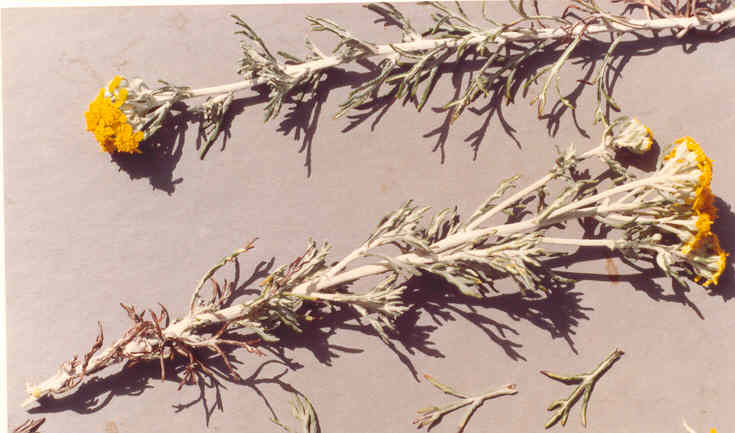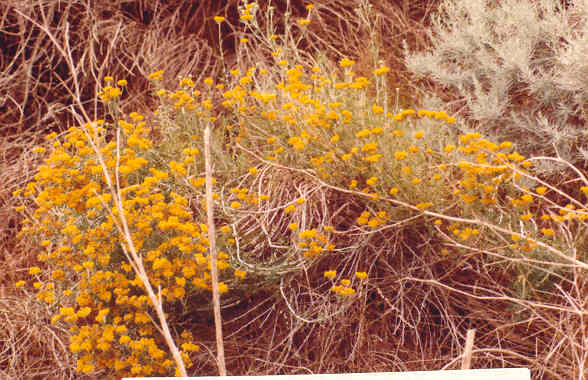
 |
Eriophyllum confertiflorum var. confertiflorum (D.C.) A. GrayAsteraceae (Sunflower Family)NativeGolden Yarrow |
March Photo
Plant Characteristics:
Perennial, somewhat woody at base to quite shrubby, the stems slender, simple or
few-branched, finely white-tomentose, 3-6 dm. tall; lvs. 2-3 cm. long,
pinnatifid or bipinnatifid into linear almost filiform divisions not over 1 mm.
wide, bright green above, white tomentose beneath, with revolute margins; heads
almost sessile in small corymbose clusters; invol. oblong, 3-4 mm. long,
floccose-glabrate, the phyllaries ca. 5, ovate; rays 4-6, yellow, 3 mm. long;
pappus of 8-12 hyaline paleae, subequal, ca. 0.5 mm. long.
Habitat:
Dry slopes and washes near the coast; Coastal Sage Scrub, Chaparral; n.
L. Calif. to n. Calif. Below 3000
m. April-Aug.
Name:
Greek, erion, wool, and phyllon, lf., the herbage wooly.
(Munz, Flora So. Calif. 163).
Confertiflorum means flowers that are crowded.
(Dale 63).
General:
Occasional in the study area. Photographed
in the Santa Ana Heights area, along Back Bay Dr. between the Newporter Inn and
San Joaquin Hills Dr., and again along Back Bay Dr. between Big Canyon and
Eastbluff Dr. (my comments). The blossoms in form and arrangement suggest
true yarrow, Achillea millefolium
which is white. (Dale 63).
Certain species of shrubs, herbs, and suffrutescents have seeds that
require fire for germination. Although
our information on the subject is far from complete, there are two
well-documented mechanisms. Certain
plants, such as Ceanothus species, broom-rose, and species of largely herbaceous
genera such as Lotus or Lupinus,
are stimulated by the intense heat of fire.
These species are all characterized by seed coats with a well-developed
cuticle that prevents uptake of water and consequently germination.
Heat either melts or cracks this cuticle.
Another mechanism studied in recent years is the chemical stimulation of
germination by a compound produced by the charring of wood.
This has been observed is species of Phacelia
and in Emmenanthe penduliflora, Eriophyllum
confertiflorum, Silene multinervia,
and Papaver californicum.
These species do not produce seed coats with an impermeable cuticle and
apparently are capable of taking up water, yet still do not germinate.
Apparently the stimulatory chemical affects permeability, perhaps
allowing greater oxygen uptake of some membrane under the seed coat.
The chemicals responsible for stimulating germination have not been
identified. (Keeley, Jon E. and
Sterling C. "Chaparral and
Wildfires." FREMONTIA, A
Journal of the California Native Plant Society. October 1986. p. 20).
For additional data on wildfires see Bloomeria
crocea, Phacelia tanacetifolia,
Lolium perenne,
and Salvia
columbariae. (my comment).
Seeds of this plant, which abounds from sea level to 8,000 feet along the
western edges of the Colorado Desert, were gathered by the Cahuilla, Indians of
the San Bernardino and San Jacinto Mountains and the Colorado
Desert, as a food.
Available in different areas from
June to November, the seeds were parched and ground into flour.
The plant is also said to have been used for medicinal purposes that are
today forgotten. (Bean and Saubel 72).
Munz lists 10 species in Flora So.
Calif. that are within the scope of that text.
There is no listing of the number of species in the genus.
The 1993 Jepson Manual lists var.
confertiflorum, and var.
tanacetiflorum, while Munz, Flora So.
Calif. lists var. confertiflorum and var.
laxiflorum. In the spring of
1994 I confirmed that the local var. is confertiflorum.
In making this confirmation, I noted that at least some fls. in some
clusters of most plants have 7 or 8 petals rather than the 4-6 noted in Munz and
Jepson. John Johnson commented that
this is not unusual in plants, where variation in the absolute number of parts
is common. (my comments).
Hybridizes with E. lanatum. (Hickman Ed. 264).
Delfina Cuero, a Kumeyaay or Southern Diegueno Indian, made the following
comments about Eriophyllum confertiflorum
in her autobiography: " This
is used for someone with pimples on their face.
They were told to boil the whole plant and wash face in water to clear
away the pimples". (Shipek 90).
Text Ref:
Hickman, Ed. 264; Munz, Calif.
Flora 1149; Munz, Flora So. Calif.
163.
Photo Ref:
June 2 83 # 16; Mar 1 84 # 17; Feb 88 # 6A,7A,8A.
Identity: by R. De Ruff,
confirmed by F. Roberts.
First Found: June 1983.
Computer Ref: Plant Data 168.
Have plant specimen.
Last edit 7/30/05.
 |
June Photo